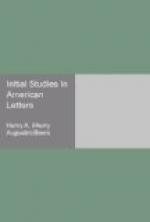of amusement to the public. Hawthorne’s
humor was quiet and fine, like Irving’s, but
less genial and with a more satiric edge to it.
The book last named was written at Salem and published
in 1850, just before its author’s removal to
Lenox, now a sort of inland Newport, but then an unfashionable
resort among the Berkshire hills. Whatever obscurity
may have hung over Hawthorne hitherto was effectually
dissolved by this powerful tale, which was as vivid
in coloring as the implication of its title.
Hawthorne chose for his background the somber life
of the early settlers of New England. Ho had
always been drawn toward this part of American history,
and in Twice-Told Tales had given some illustrations
of it in Endicott’s Red Cross and Legends
of the Province House. Against this dark
foil moved in strong relief the figures of Hester
Prynne, the woman taken in adultery; her paramour,
the Rev. Arthur Dimmesdale; her husband, old Roger
Chillingworth; and her illegitimate child. In
tragic power, in its grasp of the elementary passions
of human nature and its deep and subtle insight into
the inmost secrets of the heart, this is Hawthorne’s
greatest book. He never crowded his canvas with
figures. In the Blithedale Romance and
the Marble Faun there is the same parti carre
or group of four characters. In the House
of the Seven Gables there are five. The last
mentioned of these, published in 1852, was of a more
subdued intensity than the Scarlet Letter,
but equally original, and, upon the whole, perhaps
equally good. The Blithedale Romance,
published in the same year, though not strikingly
inferior to the others, adhered more to conventional
patterns in its plot and in the sensational nature
of its ending. The suicide of the heroine by
drowning, and the terrible scene of the recovery of
her body, were suggested to the author by an experience
of his own on Concord River, the account of which,
in his own words, may be read in Julian Hawthorne’s
Nathaniel Hawthorne and His Wife. In
1852 Hawthorne returned to Concord and bought the
“Wayside” property, which he retained until
his death. But in the following year his old
college friend Pierce, now become President, appointed
him consul to Liverpool, and he went abroad for seven
years. The most valuable fruit of his foreign
residence was the romance of the Marble Faun,
1860, the longest of his fictions and the richest
in descriptive beauty. The theme of this was
the development of the soul through the experience
of sin. There is a haunting mystery thrown about
the story, like a soft veil of mist, veiling the beginning
and the end. There is even a delicate teasing
suggestion of the preternatural in Donatello, the
Faun, a creation as original as Shakespeare’s
Caliban or Fouque’s Undine, and yet quite on
this side the border-line of the human. Our Old
Home, a book of charming papers on England, was
published in 1863. Manifold experience of life




